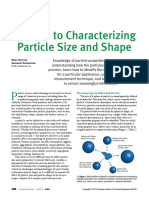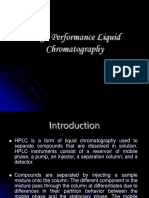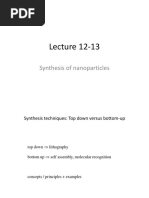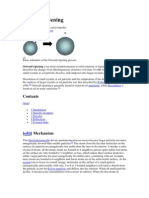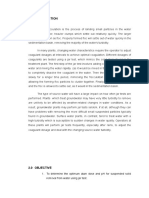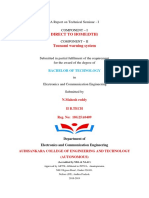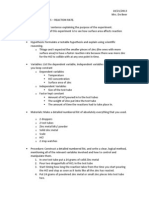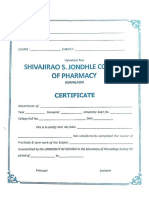Flocculation
Uploaded by
Ruth LimboFlocculation
Uploaded by
Ruth LimboDEWATERING: FLOCCULATION
Alistaire Kerwin A. Acma, Ruth Limbo, Gretchen Balahay,
Wilfredo Gatdula Jr., Jason John Joshua Paraguya, feat. Novei Almane Gorres
METE 128: MINERAL PROCESSING LABORATORY
ABSTRACT
Flocculation is important processes in water treatment with coagulation to destabilize particles through
chemical reaction between coagulant and colloids, and flocculation to transport the destabilized particles that
will cause collisions with floc. Standard flocculation procedure was carried out to determine the actual density
of the sample. Then, data gathering, analysis, and calculations were applied to obtain results.
aims to familiarize the student with the influence of
flocculating agents on the settling rate of a pulp.
INTRODUCTION
Finely divided clay particles which are dispersed in
water that eventually settle out because of gravity
are called as Colloids. In Mineral processing,
colloids are the feed produced from various mineral
processing operations which have sizes that are
approximately sizes from 5 to 1000 nm. Most of
these processes are accomplished by using water or
by using any other non-compressible fluid (liquid),
thus, leading the fine particles to be partially
suspended in the liquid. To lessen the cost of
transport for shipment in producing a dry
concentrate, the liquid then are to be removed from
the solid particles through the process called
Dewatering.
Dewatering means to remove water absorbed by
the particles which increases the pulp density. This
is done for a number of reasons, specifically, to
enable ore handling and concentrates to be
transported easily, allow further processing to occur
and to dispose of the gangue. The water extracted
from the ore by dewatering is recirculated for plant
operations after being sent to a water treatment
plant.
Under this process, there are three methods
involved namely: sedimentation, filtration, and
thermal drying. Moreover, Sedimentation can be
classified into three also, namely Sedimentation
through
flocculation,
thickening
(gravity
sedimentation), and centrifugal sedimentation.
In the process of flocculation, the fine particles
(colloids) suspended in the water can by group
together to form floccules large enough to be seen
by the naked eye, the resulting flocs will settle then
faster providing then a clear supernatant liquid and
a compacted sediment in a reasonable time.
OBJECTIVES OF THE STUDY
This activity will aim to introduce the process of
dewatering to the students and let them be able to
determine, observe and understand the mechanism
of particles that are suspended in the water. It also
SIGNIFICANCE OF THE STUDY
Flocculation is important processes in water
treatment with coagulation to destabilize particles
through chemical reaction between coagulant and
colloids, and flocculation to transport the
destabilized particles that will cause collisions with
floc.The use of polymer as a flocculating agent
should be done with great care because an overdose
will make the setting process difficult. As they are
lighter than water, a high dose of anionic polymer
will increase the floating ability of flocculation.
MATERIALS AND METHODS
The materials used where 500 ml graduated
cylinder, wash bottle, flocculants, stirring rod ,
placer ore, stopwatch, aluminum pan,
and
analytical weighing balance.
Flocculation method, which is a specific
requirement of dewatering or a solid- liquid
separation, such as sedimentation, was employedin
this activity. Flocculation involves the formation of
much more open agglomerates and relies upon
molecules of reagent acting as bridges between
separate suspended particles.
In this activity, the raw material which is gold
placer was prepared and was kneaded
simultaneously. Gold placer sample was weighed
and was then dissolved first in a distilled water in a
beaker. And then the dissolved sample was poured
out in a 500 ml graduated cylinder and then water
was added to remove residual samples on the
beaker until it reaches 500 ml, then was stirred
using stirring rod. A 25 ml of distilled water was
then added to 500 ml solution, after that a
flocculants was added, and was stirred vigorously.it
is to ensure that no accumulation of particles at the
bottom of the graduated cylinder. After it has been
stirred, it was noticed that the particles settles
Flocculation.Submitted to Engr. Leaniel C. Silva, Instructor. Page 1 of 4
rapidly, and the time for settling of particles was
noted. And from the surface the particles then
settle to 400 ml surface, and from then it settle to
300 ml surface and finally it was allowed to settle
down to the bottom.
With the same raw material, another trial was made
but with a different flocculant added. With the same
procedure as the first trial, rapid settling of particles
was also observed, in which the time was recorded
as the particles settled, from the surface of 525 ml
solution it takes seconds until it settled to 400 ml,
also seconds until it settled at 300 ml and then
finally it was allowed to settle completely to the
bottom.
In the third trial, a different flocculant was again
used. With the same procedure in trial 1 and 2 ,
after the flocculants was added, the solution was
stirred properly and was allowed to settle. The time
required for the particles to settle was recorded.
And as the particles settled, from the surface of 525
ml solution it takes seconds until it settled to 400
ml, also seconds until it settled at 300 ml and then
finally it was allowed to settle completely to the
bottom.
Figure1. Process flow chart for Flocculation
Method in three different flocculants.
Preparing the Sample
Weighing of the Sample
Dissolving of the sample in a distilled water
RESULTS AND DISCUSSION
For economical purposes, it is essential that the
concentrates be transported with moisture content
enough to eliminate, or at least minimize, dust
losses. Hence, product is subjected to dewatering
methods: sedimentation, filtration and thermal
drying. Bulk of the liquid is removed through
sedimentation producing 55-65% solids by weight.
This study exploits flocculation, a process involved
in sedimentation, by using a variety of flocculants
on a placer ore.
In general, flocculation is the agglomeration of
separate suspended particles relying greatly on the
bridges created by the flocculants. As such, in
theory, this process does not alter the properties of
the particles chemically. The rate of aggregation
depends on the collision rate between particles and
collision effectiveness in permitting attachment
between particles. Assuming that every particle
collision leads to clustering then the determining
rate is the collision rate of particles, termed as
Brownian motion. It is the random motion of the
colloidal particles which results from the rapid and
random bombardment of the colloidal particles by
molecules of the fluid. Technically, however,
Brownian motion only applies on particle sizes less
than 5 m. Beyond this size, aggregation is
governed by applied mixing or orthokinetic
flocculation.
This activity was conducted with three (3) trials,
corresponding to the three (3) different flocculants.
The weight of the placer ore and volume of
flocculants were determined using the following
equations:
Specific Gravit y placer :
Placing of the sample in the 500 beaker
Adding of 25 ml Distilled Water
Adding of the Flocculants
Stirring of the Solution
Ms
25(M py+ w+sM py+ s)
x=
(eq .1)
100 SG placer ( D p1)
(eq .2)
D p (SG placer 1)
Weigh t placer =( 0.5 L ) 1200
g
L
)( 100x )( eq .3)
Settling of the Particles
Gathering of Data
Volum e floc :=
(Weight placer )(Dosage)(
1000
)
floc strength
1,000,000
Flocculation.Submitted to Engr. Leaniel C. Silva, Instructor. Page 2 of 4
(eq .4
The table below contains initial assumptions:
Table 1. Assumptions for calculation purposes.
FLOC
FLOCCULAN
DOSAGE
STRENGTH
(gpt)
(%)
Superfloc A110
2.5
Superfloc A120
1
Magnafloc
2.5
Pulp Density= 1200gpL
3
3
3
The following table is consist of the calculated
data:
Table 2. Calculated quantity
pulp.
LEGEND
Specific Gravity (placer)
Percent solids
Weight (placer)
Superfloc A110
Superfloc A120
Magnafloc
of the constituents of
AMOUNT
2.42 g/mL
28.4%
170.4 g
0.204 mL
0.511 mL
0.204 mL
The
three
(3)
flocculants
are
anionic
polyacrylamides but differ on charge density and
molecular weights. Anionic polyacrylamide is
recommended for a pronounced effect on the
bridging role of flocculants. Moreover, these
flocculants have higher molecular weight, implying
longer chain, and are less expensive compared to
cationics. The mode of action of the anionic
polyacrylamide depends on a segment of the very
long molecule being adsorbed on the surface of a
particle, leaving a large proportion of the molecule
free to be adsorbed on another particle, so forming
an actual molecular linkage, or bridge, between
particles. For an effective flocculation the polymer
must exhibit good adsorption on the surface, and
the agitation during flocculation and subsequent
agitation is optimized. Also, it should be noted that
excess polymer can cause dispersion of the
particles due to floc breakdown. Practically,
flocculants is added prior to sedimentation
combining it evenly to the incoming feed.
Table 3. Flocculating time of different flocculants.
TIME (seconds)
CALIBRA
SUPERF SUPERF
TION
MAGNA
LOC
LOC
(mL)
FLOC
A110
A120
500
0
0
0
450
25.39
63.54
94.22
400
40.42
133.72
173.87
350
135.04
233.54
202.86
300
222.05
323.44
231.45
TOTAL
TIME:
422.9 sec
754.24
702.4 sec
Based on the data reflected on table 3, the settling
time increases for each calibration on all the
flocculants. This is due to the decrease in the
availability of free sites in the polymers over time.
The magnafloc displayed the strongest flocculating
power followed by superfloc A120 and lastly by
superfloc A110. Even at a floc strength of 1%, the
superfloc A120 is superior to superfloc A110. This
coincides with the fact that superfloc A120 has a
higher molecular weight and has been used
commercially in concentrate and tails thickening.
Without specifically knowing the type of
magnafloc but rather based on its performance, it is
safe to say that the magnafloc utilized in this study
has a longer chain compared to the superfloc
A120.In the next 48 hours, the three solutions
reached a common calibration of 160 mL and
produced a clear supernatant fluid implying that all
the particles have settled.
Another process which works hand in hand with
flocculation in effectively producing a supernatant
liquid is coagulation. Unlike flocculation,
coagulation causes extremely fine colloidal
particles to adhere directly to each other. This is
caused by the attractive forces of the London Van
der Waals which take only in effect in short
distances. Normally, the adhesion due to these
forces is prevented by the presence around each
particle of an electrically charged atmosphere,
which generates repulsion forces between particles
approaching each other (Fig. 2).
Figure 2. Electrical double layer.
Flocculation.Submitted to Engr. Leaniel C. Silva, Instructor. Page 3 of 4
In solution, the presence of a net charge on a
particle affects the distribution of ions surrounding
it, resulting in an increase in the concentration of
counter-ions. The region over which this influence
extends is called the electrical double layer.
Assuming the surface charge in figure 2 is negative,
the first layer of positive charges attracted on the
surface is called stern layer. The subsequent layer,
Guoy/diffuse layer, contains potential determining
ions which further neutralize the negative surface
charge emitted by the particle. As the particle
moves through solution the ionsmove with it. At
some distance from theparticle there exists a
boundary, beyondwhich ions do not move with
the particle. Thisis known as the slipping plane, and
existssomewhere within the diffuse layer. It is
thepotential that exists at the slipping plane that is
defined as the zeta potential.
Zeta potential (ZP) is crucial in determining the
occurrence of coagulation. A large ZP, negative or
positive, insinuates a large electric double layer and
hence, eliminates the possibility of particle
adhesion. To establish the optimum condition for
coagulation, the isoelectric point of the solution
must be ascertained through plotting ZP versus pH.
Isoelectric point is indicated by change reversal
implying the net charge on the particles is zero.
of flocs. After 48 hours, the flocculated samples
reached the level of 160 mL and each produced
supernatant liquid. Both implies that all particles
have settled. In recommendation, proper
calculation of data must be ensued especially in
determining the specific gravity to avoid a negative
domino effect.
REFERENCES
Bohuslav Dobias, Coagulation and Flocculation: Theory and
Applications, 1993-01-19, pp 169-172
Steven N. Liss, Ian G. Droppo, Gary G. Leppard, Timothy G.
Milligan, Flocculation in Natural and Engineered
Environmental Systems, 2004-12-28, pp 35-37
K.J. Ives, The Scientific Basis of Flocculation, 2012-12-06
https://www.koshland-sciencemuseum.org/water/html/en/Treatment/Coagulation-Flocculationtechnologies.html
http://www.iwawaterwiki.org/xwiki/bin/view/Articles/Coagulati
onandFlocculationinWaterandWastewaterTreatment
Alternately, coagulants can be added to help hasten
the agglomeration. Coagulants are electrolytes
having an opposite charge to the particle, thus
causing charge neutralization when dispersed in the
system, allowing the particles to come into contact
and adhere as a result of molecular forces.
Common coagulants are inorganic salts such as Al+
++, Fe+++ and Ca++.
CONCLUSION AND RECOMMENDATION
Retained moisture of the concentrates is vital in
minimizing transport costs and dust losses and is
manipulated via dewatering. The bulk of the water
is removed through sedimentation which can be
explained through coagulation and flocculation.
This study focuses on flocculation and exploits it
by using three different types of flocculants in
agglomerating placer ore. It has been procured that
amongst the flocculants utilized, it is the
magnaflocs which has superior flocculating ability
followed by superfloc A120 and lastly by superfloc
A110. This implies that the magnaflocs has longer
chains of polymers which adsorbs on the surface of
the particles and hence, a higher molecular weight.
Other factors influencing the degree of flocculation
are the efficiency of adsorption on the surface,
degree of agitation during flocculation and the
subsequent agitation which can result in breakdown
Flocculation.Submitted to Engr. Leaniel C. Silva, Instructor. Page 4 of 4
You might also like
- Cell Fractionation, Advantages and Disadvantages67% (3)Cell Fractionation, Advantages and Disadvantages1 page
- Polymers For Coagulation, Flocculation and Dewatering of Solids and SludgeNo ratings yetPolymers For Coagulation, Flocculation and Dewatering of Solids and Sludge15 pages
- MEng - Effect of Slurry Rheology On Gas Dispersion in A Pilot-Scale Mechanical Flotation CellNo ratings yetMEng - Effect of Slurry Rheology On Gas Dispersion in A Pilot-Scale Mechanical Flotation Cell7 pages
- Effect of The Bubble Size On The Dynamic Adsorption of Frothers and Collectors in FlotationNo ratings yetEffect of The Bubble Size On The Dynamic Adsorption of Frothers and Collectors in Flotation9 pages
- Selective Depression of Pyrite With Polya - 2001 - International Journal of MineNo ratings yetSelective Depression of Pyrite With Polya - 2001 - International Journal of Mine10 pages
- The Surface and Solution Chemistry of Pyrite Flotation With - Mariana - OCRNo ratings yetThe Surface and Solution Chemistry of Pyrite Flotation With - Mariana - OCR12 pages
- Chalcopyrite and Pyrite Floatabilities in The Presence of Sodium Sulphide and Sodium Metabisulfite in A High Pyritic Copper Complex OreNo ratings yetChalcopyrite and Pyrite Floatabilities in The Presence of Sodium Sulphide and Sodium Metabisulfite in A High Pyritic Copper Complex Ore9 pages
- Laboratory Cake Filtration Testing Using Constant RateNo ratings yetLaboratory Cake Filtration Testing Using Constant Rate10 pages
- Bio150 Final Online Test Question July 2020 - ArauNo ratings yetBio150 Final Online Test Question July 2020 - Arau10 pages
- 1 - Text - A Guide To Characterizing Particle Size and Shape - 23AGO2020No ratings yet1 - Text - A Guide To Characterizing Particle Size and Shape - 23AGO202011 pages
- Depression of Pyrite by Metabisulfite and Sulfite Ions in Seawater andNo ratings yetDepression of Pyrite by Metabisulfite and Sulfite Ions in Seawater and11 pages
- The Separation of Kyanite From Quartz by Flotation at Acidic PH 2016 Minerals EngineeringNo ratings yetThe Separation of Kyanite From Quartz by Flotation at Acidic PH 2016 Minerals Engineering8 pages
- 2-Hydrodynamic Methods (Sedimentation, Centrifugation and UltracentrifugationNo ratings yet2-Hydrodynamic Methods (Sedimentation, Centrifugation and Ultracentrifugation24 pages
- Chromatography: Jump To Navigationjump To SearchNo ratings yetChromatography: Jump To Navigationjump To Search22 pages
- Contributions To An Improved Understanding of The Flotation ProcessNo ratings yetContributions To An Improved Understanding of The Flotation Process70 pages
- Hemicellulose Bioconversion: Review PaperNo ratings yetHemicellulose Bioconversion: Review Paper13 pages
- Physical Processes in Bioreactors: Bioprocess TechnologyNo ratings yetPhysical Processes in Bioreactors: Bioprocess Technology31 pages
- Analytical Chemistry Ii - Fundamentals of Analytical Chemistry - Quantitative AnalysisNo ratings yetAnalytical Chemistry Ii - Fundamentals of Analytical Chemistry - Quantitative Analysis20 pages
- Ruth G. Limbo ES 205 Assignment: Exercise 1No ratings yetRuth G. Limbo ES 205 Assignment: Exercise 11 page
- UniMasr.com_f0922f3495133e72e29ab20ecea19ee2.docxNo ratings yetUniMasr.com_f0922f3495133e72e29ab20ecea19ee2.docx22 pages
- Scientific Computing: Interpolation - Polynomial InterpolationNo ratings yetScientific Computing: Interpolation - Polynomial Interpolation19 pages
- HSE Advisory - Chemicals For Cleaning Sanitisation and DisinfectionNo ratings yetHSE Advisory - Chemicals For Cleaning Sanitisation and Disinfection8 pages
- Simon C. Bott Et Al - Quantitative Measurements of Wire Ablation in Tungsten X-Pinches at 80 KaNo ratings yetSimon C. Bott Et Al - Quantitative Measurements of Wire Ablation in Tungsten X-Pinches at 80 Ka6 pages
- Mattias Lab Report Surface Area Reaction RateNo ratings yetMattias Lab Report Surface Area Reaction Rate3 pages
- 1 Introduction To Quantum Mechanics Unit INo ratings yet1 Introduction To Quantum Mechanics Unit I12 pages
- MATSCI 210 - Lecture 4 - Entropic ElasticityNo ratings yetMATSCI 210 - Lecture 4 - Entropic Elasticity34 pages
- GK - Structure of Atmosphere - TutorialspointNo ratings yetGK - Structure of Atmosphere - Tutorialspoint3 pages
- STEM 6 Determining The Concentration of Acetic Acid in Vinegar Via Acid Base TitrationNo ratings yetSTEM 6 Determining The Concentration of Acetic Acid in Vinegar Via Acid Base Titration11 pages
- Polymers For Coagulation, Flocculation and Dewatering of Solids and SludgePolymers For Coagulation, Flocculation and Dewatering of Solids and Sludge
- MEng - Effect of Slurry Rheology On Gas Dispersion in A Pilot-Scale Mechanical Flotation CellMEng - Effect of Slurry Rheology On Gas Dispersion in A Pilot-Scale Mechanical Flotation Cell
- Effect of The Bubble Size On The Dynamic Adsorption of Frothers and Collectors in FlotationEffect of The Bubble Size On The Dynamic Adsorption of Frothers and Collectors in Flotation
- Selective Depression of Pyrite With Polya - 2001 - International Journal of MineSelective Depression of Pyrite With Polya - 2001 - International Journal of Mine
- The Surface and Solution Chemistry of Pyrite Flotation With - Mariana - OCRThe Surface and Solution Chemistry of Pyrite Flotation With - Mariana - OCR
- Chalcopyrite and Pyrite Floatabilities in The Presence of Sodium Sulphide and Sodium Metabisulfite in A High Pyritic Copper Complex OreChalcopyrite and Pyrite Floatabilities in The Presence of Sodium Sulphide and Sodium Metabisulfite in A High Pyritic Copper Complex Ore
- Laboratory Cake Filtration Testing Using Constant RateLaboratory Cake Filtration Testing Using Constant Rate
- Bio150 Final Online Test Question July 2020 - ArauBio150 Final Online Test Question July 2020 - Arau
- 1 - Text - A Guide To Characterizing Particle Size and Shape - 23AGO20201 - Text - A Guide To Characterizing Particle Size and Shape - 23AGO2020
- Depression of Pyrite by Metabisulfite and Sulfite Ions in Seawater andDepression of Pyrite by Metabisulfite and Sulfite Ions in Seawater and
- The Separation of Kyanite From Quartz by Flotation at Acidic PH 2016 Minerals EngineeringThe Separation of Kyanite From Quartz by Flotation at Acidic PH 2016 Minerals Engineering
- 2-Hydrodynamic Methods (Sedimentation, Centrifugation and Ultracentrifugation2-Hydrodynamic Methods (Sedimentation, Centrifugation and Ultracentrifugation
- Contributions To An Improved Understanding of The Flotation ProcessContributions To An Improved Understanding of The Flotation Process
- Physical Processes in Bioreactors: Bioprocess TechnologyPhysical Processes in Bioreactors: Bioprocess Technology
- Analytical Chemistry Ii - Fundamentals of Analytical Chemistry - Quantitative AnalysisAnalytical Chemistry Ii - Fundamentals of Analytical Chemistry - Quantitative Analysis
- Scientific Computing: Interpolation - Polynomial InterpolationScientific Computing: Interpolation - Polynomial Interpolation
- HSE Advisory - Chemicals For Cleaning Sanitisation and DisinfectionHSE Advisory - Chemicals For Cleaning Sanitisation and Disinfection
- Simon C. Bott Et Al - Quantitative Measurements of Wire Ablation in Tungsten X-Pinches at 80 KaSimon C. Bott Et Al - Quantitative Measurements of Wire Ablation in Tungsten X-Pinches at 80 Ka
- STEM 6 Determining The Concentration of Acetic Acid in Vinegar Via Acid Base TitrationSTEM 6 Determining The Concentration of Acetic Acid in Vinegar Via Acid Base Titration

























